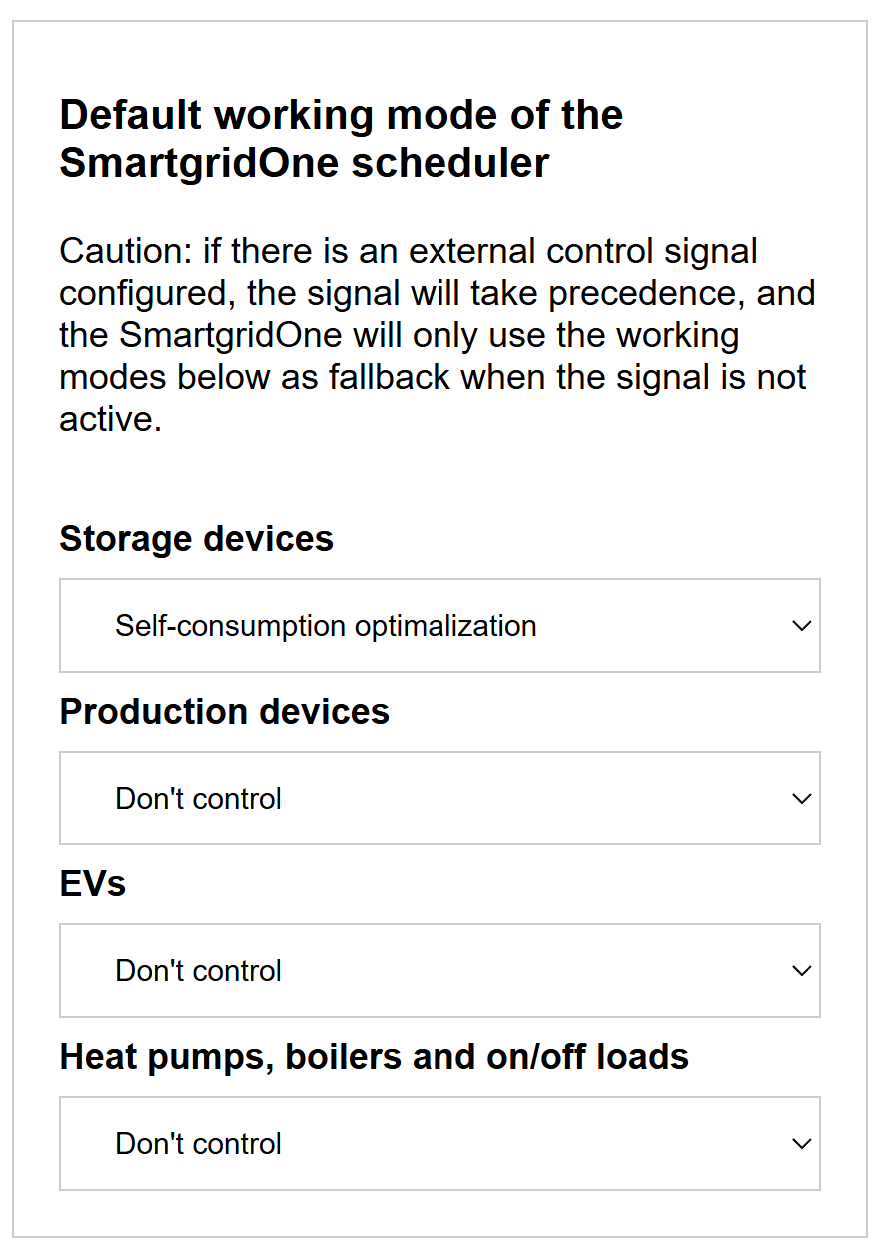Setting the local control modes
Setting the control modes
note
The default control modes are requested during the initial setup. You can change them later under the "Settings" menu.
external signals
If external control signals (Yuso, Edmij, Frank Energie, ...) are active, the external control signal has priority and the default control modes will be used as fallback.
Full explanation
Below is a brief description of the available control modes. For more information, see the document "Control modes of the SmartgridOne Controller".
Under "Default working mode" choose for each type of device which type of control mode you want to use.

STORAGE DEVICES (BATTERY SYSTEMS)
- Don't control: No active control. (Note that this can be overwritten by an external signal).
- Self-consumption optimalization: Charging when there is excess solar power, and discharging when energy is taken from the grid.
- Cost optimalization: Charge with the least expensive possible energy, and cover consumption at the most expensive times. You can optionally allow energy trading.
- Peak shaving only: Discharge at times of peak consumption from the grid, and charge at off-peak times. You can set your own threshold values for this.
- Exclusive control through external API: Only charge and discharge according to external control signals.
PRODUCTION DEVICES
- Don't control: No active control. (Note that this can be overwritten by an external signal).
- Cost optimalization: PV production is turned off at negative purchase prices (you are then paid to consume), and limited to your energy consumption at negative sales prices (you pay to inject your surplus). At other times, PV production is limited to allowable feed-in power.
- Feed in restriction till allowed grid export power: Limit PV production to the allowed grid export power.
- Exclusive control via external API: Only limit PV production according to external control signals.
EVs (ELECTRIC VEHICLES)
Minimum charging current
Most electric vehicles always require a minimum charging current of 6A. So possibly charging is not reduced to zero when ideally it should be.
- Don't control: No active control. (Note that this can be overwritten by an external signal).
- Self-consumption optimalization: Charging when there is excess solar power.
- Cost optimalization: Charge with the least expensive possible energy.
- Peak shaving only: Limit charging to the maximum allowed grid import power.
HEAT PUMPS, BOILERS AND ON/OFF LOADS
- Don't control: No active control. (Note that this can be overwritten by an external signal).
- Self-consumption optimalization: Prefer consumption when there is surplus solar energy. There are three submodes:
- Only schedule when there is surplus production, but still allow that switching the heat pump / boiler or on/off load on causes import from the grid.
- Only schedule when there is sufficient surplus production to not cause import from the grid.
- Prefer scheduling at moments of surplus production, but also schedule at moments of low import.
- Cost optimalization: Prefer consumption with the least expensive possible energy.
- Peak shaving only: Limit consumption when grid power exceeds a threshold.
- Always powered on: Always on unless overridden by an external control signal.
- Always powered off: Always off, unless overridden by an external control signal.